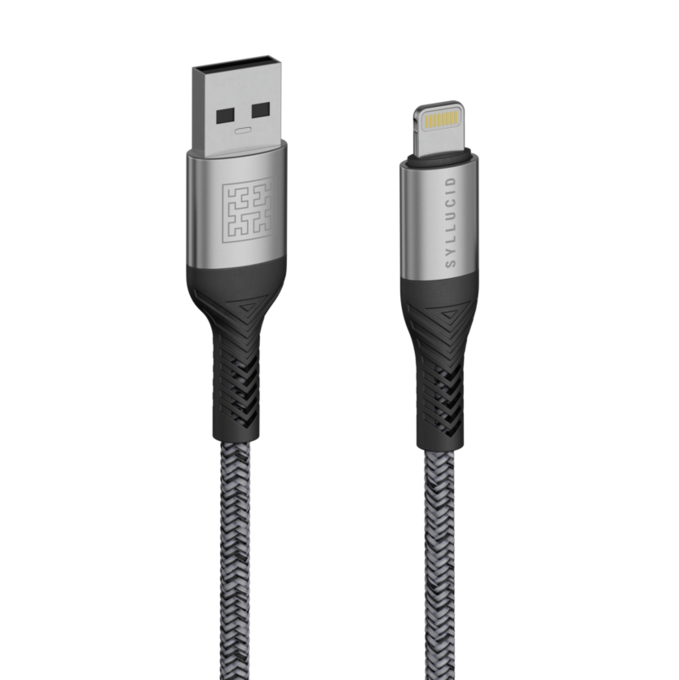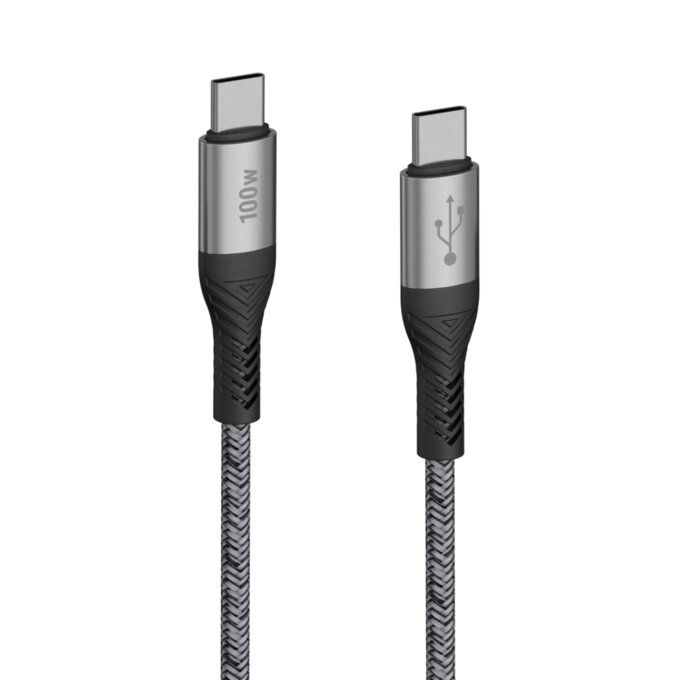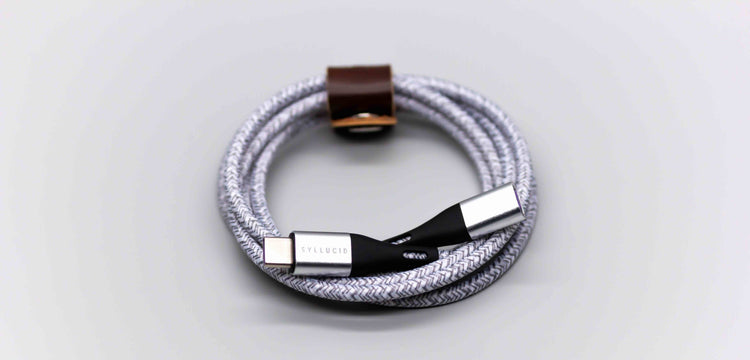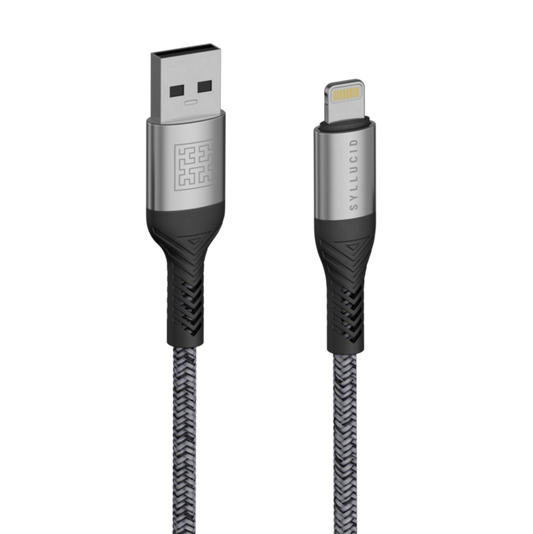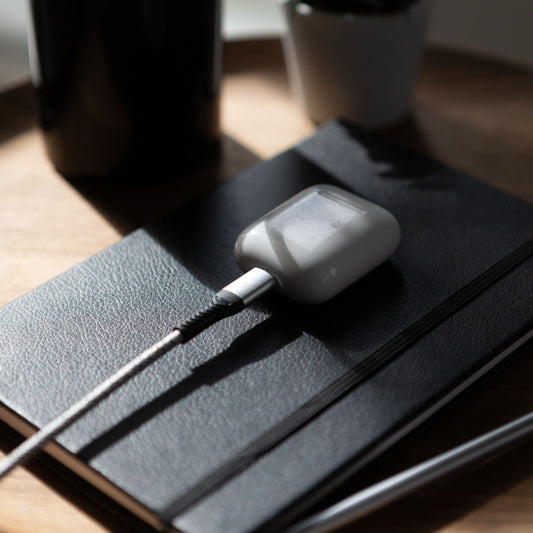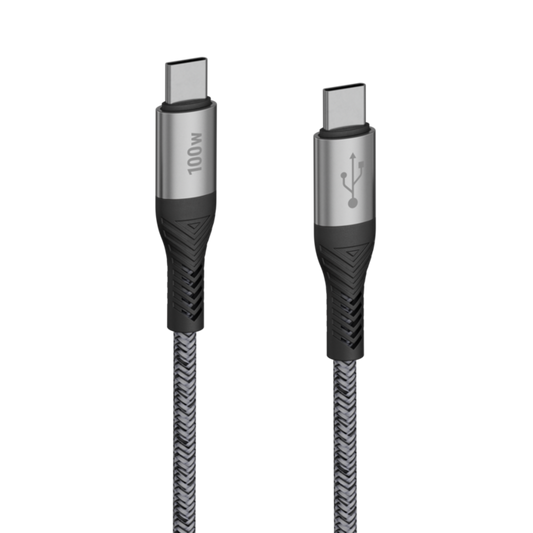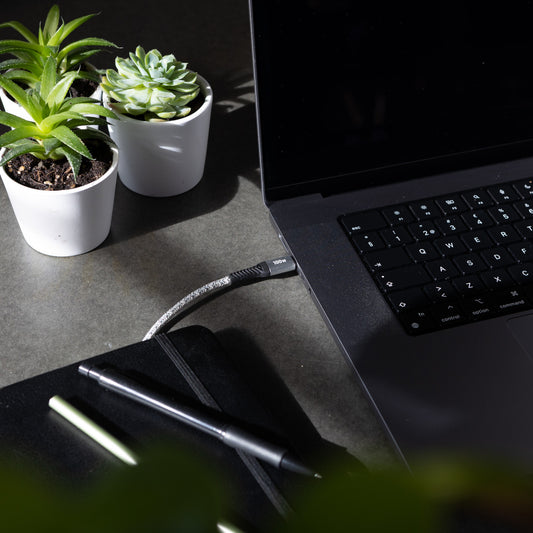Take the stress out of shopping for good tech. Here’s how to choose the right USB cable for your needs.
Good news! In a bid to reduce e-waste and branded monopolies, EU legislation will make USB C charging cable the norm by the end of 2024. Until then, most of our devices have different charging ports, and if we keep them for years (which is best for the planet), then we need charging cables that fit.
“Even though USB cables can look the same, there are so many options. They can differ wildly and it can become complicated quickly. We want to simplify things for everyone.”
— Fabian Hühne, MD of Syllucid
After years of research and testing, our engineering experts walk you through the process so you can balance quality, budget and functionality.
10 things to look for when buying a new USB cable
- Device compatibility
- Charging power
- Data transfer speed
- Cable length
- Durability
- Guarantee
- Price
- Sustainability credentials
- Certifications
- Reviews
1. Device compatibility
It’s safe to use USB cables for many different brands, even when they aren’t part of their ‘branded ecosystem’ of cables. However, do make sure to choose a cable that is compatible with your devices. Essential for that are the connectors. Make sure to check your devices and charging socket first before you buy a cable.
The connector is the metal part that goes into the charging port. The most common types of connectors are Type-A, Type-B, Type-C, Micro-B, Mini-B and lightning (Apple). When in doubt, google which connector your device uses.

USB charging cable types with different connectors including mini USB, micro USB, USB C and more. Source: Ifi Audio
A good option when you have multiple devices with different connectors is a modular cable so you only need one cable for your phone, laptop, e-reader, headphones and speakers.
2. Charging power
If you plan on using your USB cable to charge devices like your phone or laptop, make sure it has the ability to deliver enough power. Check the specifications of your devices to ensure the cable you choose has the necessary power delivery capabilities. 60W is ample for most devices. Modern cables often use Power Delivery (PD), a technology to allow for even faster charging up to 240W.
While it's important to make sure that your cable can deliver enough power to charge your device (a 30W cable will charge a laptop that needs 65W at a lower speed) - there is no need to worry about having a cable to that is too strong. A USB cable that can deliver 100W will also charge a phone that only requires 30W to be charged at top speed without any complications.
|
Power |
Supported devices |
|
10W |
Smartphones, hard drives, headphones, small accessories |
|
18W |
Smartphones, tables, larger accessories |
|
36W |
Future smartphones, notebooks, displays, hubs |
|
60W |
Laptops, larger notebooks, hubs, docking stations |
|
100 - 240W |
Larger laptops, workstations, external graphic cards |
Charging cable power (W) needed for different devices. Source: Manhattan Products
Every phone manufacturer has developed their own charging protocol using USB charging cables. Those include:
- Qualcomm Quick Charge
- MediaTek Pump Express
- OPPO VOOC/Warp Charge (licensed to OnePlus as Dash Charge)
- Huawei SuperCharge
- Samsung Adaptive Fast Charging
Even if your cable does not support the custom charging protocols it will still charge the device, however potentially at a slightly lower speed.
3. Data Transfer Speed
In most scenarios USB 2.0 is fast enough. USB cables come in different speeds. USB 3.0 cables are a distinctive blue colour. Say you’re a videographer creating 4K video and you need a fast transfer speed, make sure to choose a cable with a higher speed rating. Most data cables like HDMI are currently being replaced with USB.
|
USB Version |
Speed Name | Speed |
|
USB 2.0 |
High Speed |
180 Mbps |
|
USB 3.0 |
SuperSpeed (SS) |
5 Gbps |
|
USB 3.1 |
SuperSpeed+ |
10 Gbps |
|
USB 3.2 |
SuperSpeed+ |
20 Gbps |
4. Cable Length
The length of the cable is an important consideration. Make sure to choose a cable that is long enough to meet your needs. 1.2m should be long enough for desk use and charging your phone at night. You might want to go for longer, or a charger with an extension cord if you know your power socket is far away.
5. Durability
The longer our electronics work, the less harm they cause the planet. A good quality USB cable should be made of durable materials and have a sturdy construction. Look for cables made to last with design elements like braiding and bend protectors to ensure they can withstand frequent use. Another aspect of the cable to look out for is its thickness. A more hidden element of any cable is the conductive wire (usually copper) that is on the inside of your cable. How thick this wire is and how well protected it is, is important to determine how long it will last. As copper is very valuable, very cheap cables often use very thin wires to save costs. That also makes them break more easily. Be wary of cables that look very thin or are comparatively extremely cheap to avoid having to buy a new one in a short period of time.
6. Guarantee
If you’re intending to invest in a long life item, it’s always worth looking out for brands that offer a guarantee or warranty. That way, you’re covered if anything goes wrong.
7. Price
USB cables can range in price. Determine your budget and choose a cable that offers the features and specifications you need at a price you can afford. Remember, if you buy cheap, you may buy twice! Cheap cables are made poorly and tend to break. If they have a single coat of plastic and no 'bend protectors', they're more likely to break. It's about a balance between quality and price. Note that the longer your electronics last, the better they are for the planet.
8. Sustainability credentials
Electronics impact climate change because they have a large carbon footprint and can cause environmental damage, such as deforestation from mining metals and e-waste. The supply chain can also be linked to slavery, child labour, gang crime, poor working conditions and minimal pay.
Two in three of us consider ourselves as belief-driven buyers. Our buying decisions increasingly focus on sustainability, social impact, ethics and environmentalism. In which real ways is the brand you’re buying from reducing its impact on the climate and people making the products?
Check for recycled metals, recycled plastic coating, carbon offsetting, and collaborations with environmental and social impact projects. They might be part of the Greentech Alliance, support Fairtrade Gold, Stannol or an environmental organisation like PUR Project in the region their materials come from.
9. Certifications
Trust badges are a good indicator of quality. For example, Qualcomm ensures fast charging. The recycling symbol is a good indicator, however it doesn’t mean the whole product is recycled. CE, RoHS, Reach, FCC and WEEE are all good certifications.
10. Reviews
Last but not least, do other people like the product? Take a look at the reviews and make sure people are positive about the cables.

Here's a positive review from one of our happy customers
By taking these factors into consideration, you can find the right USB cable to meet your needs - and the planet. But if you have any questions about our products, don't hesitate to email us at support@syllucid.com. We always love to connect with people in the community.
